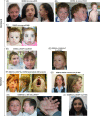Delineation of dominant and recessive forms of LZTR1-associated Noonan syndrome
- PMID: 30859559
- PMCID: PMC6563422
- DOI: 10.1111/cge.13533
Delineation of dominant and recessive forms of LZTR1-associated Noonan syndrome
Abstract
Noonan syndrome (NS) is characterised by distinctive facial features, heart defects, variable degrees of intellectual disability and other phenotypic manifestations. Although the mode of inheritance is typically dominant, recent studies indicate LZTR1 may be associated with both dominant and recessive forms. Seeking to describe the phenotypic characteristics of LZTR1-associated NS, we searched for likely pathogenic variants using two approaches. First, scrutiny of exomes from 9624 patients recruited by the Deciphering Developmental Disorders (DDDs) study uncovered six dominantly-acting mutations (p.R97L; p.Y136C; p.Y136H, p.N145I, p.S244C; p.G248R) of which five arose de novo, and three patients with compound-heterozygous variants (p.R210*/p.V579M; p.R210*/p.D531N; c.1149+1G>T/p.R688C). One patient also had biallelic loss-of-function mutations in NEB, consistent with a composite phenotype. After removing this complex case, analysis of human phenotype ontology terms indicated significant phenotypic similarities (P = 0.0005), supporting a causal role for LZTR1. Second, targeted sequencing of eight unsolved NS-like cases identified biallelic LZTR1 variants in three further subjects (p.W469*/p.Y749C, p.W437*/c.-38T>A and p.A461D/p.I462T). Our study strengthens the association of LZTR1 with NS, with de novo mutations clustering around the KT1-4 domains. Although LZTR1 variants explain ~0.1% of cases across the DDD cohort, the gene is a relatively common cause of unsolved NS cases where recessive inheritance is suspected.
Keywords: LZTR1; Noonan syndrome; RAS-MAPK signalling; developmental disorder; exome.
© 2019 The Authors. Clinical Genetics published by John Wiley & Sons A/S. Published by John Wiley & Sons Ltd.
Conflict of interest statement
The authors have no conflict of interest to report.
Figures


References
-
- Noonan JA. Hypertelorism with turner phenotype. A new syndrome with associated congenital heart disease. Am J Dis Child. 1968;116(4):373‐380. - PubMed
-
- Noonan JA, Ehmke DA. Associated noncardiac malformations in children with congenital heart disease. J Pediatr. 1963;63:468‐470.
-
- Lee DA, Portnoy S, Hill P, Gillberg C, Patton MA. Psychological profile of children with Noonan syndrome. Dev Med Child Neurol. 2005;47(1):35‐38. - PubMed
-
- Nora JJ, Nora AH, Sinha AK, Spangler RD, Lubs HA. The Ullrich‐Noonan syndrome (turner phenotype). Am J Dis Child. 1974;127(1):48‐55. - PubMed
Publication types
MeSH terms
Substances
Grants and funding
LinkOut - more resources
Full Text Sources
Research Materials
Miscellaneous

